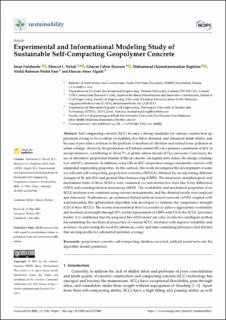| dc.contributor.author | Faridmehr, Iman | |
| dc.contributor.author | Nehdi, Moncef L. | |
| dc.contributor.author | Huseien, Ghasan Fahim | |
| dc.contributor.author | Hajmohammadian Baghban, Mohammad | |
| dc.contributor.author | Sam, Abdul Rahman Mohd | |
| dc.contributor.author | Algaifi, Hassan Amer | |
| dc.date.accessioned | 2023-01-16T10:12:21Z | |
| dc.date.available | 2023-01-16T10:12:21Z | |
| dc.date.created | 2021-12-14T13:45:57Z | |
| dc.date.issued | 2021 | |
| dc.identifier.citation | Sustainability. 2021, 13 (13), . | en_US |
| dc.identifier.issn | 2071-1050 | |
| dc.identifier.uri | https://hdl.handle.net/11250/3043641 | |
| dc.description.abstract | Self-compacting concrete (SCC) became a strong candidate for various construction applications owing to its excellent workability, low labor demand, and enhanced finish-ability, and because it provides a solution to the problem of mechanical vibration and related noise pollution in urban settings. However, the production of Portland cement (PC) as a primary constituent of SCC is energy-intensive, contributing to about 7% of global carbon dioxide (CO2) emissions. Conversely, the use of alternative geopolymer binders (GBs) in concrete can significantly reduce the energy consumption and CO2 emissions. In addition, using GBs in SCC can produce unique sustainable concrete with unparallel engineering properties. In this outlook, this work investigated the development of some eco-efficient self-compacting geopolymer concretes (SCGCs) obtained by incorporating different dosages of fly ash (FA) and ground blast furnace slag (GBFS). The structural, morphological, and mechanical traits of these SCGCs were examined via non-destructive tests like X-ray diffraction (XRD) and scanning electron microscopy (SEM). The workability and mechanical properties of six SCGC mixtures were examined using various measurements, and the obtained results were analyzed and discussed. Furthermore, an optimized hybrid artificial neural network (ANN) coupled with a metaheuristic Bat optimization algorithm was developed to estimate the compressive strength (CS) of these SCGCs. The results demonstrated that it is possible to achieve appropriate workability and mechanical strength through 50% partial replacement of GBFS with FA in the SCGC precursor binder. It is established that the proposed Bat-ANN model can offer an effective intelligent method for estimating the mechanical properties of various SCGC mixtures with superior reliability and accuracy via preventing the need for laborious, costly, and time-consuming laboratory trial batches that are responsible for substantial materials wastage. | en_US |
| dc.language.iso | eng | en_US |
| dc.publisher | MDPI | en_US |
| dc.rights | Navngivelse 4.0 Internasjonal | * |
| dc.rights.uri | http://creativecommons.org/licenses/by/4.0/deed.no | * |
| dc.title | Experimental and informational modeling study of sustainable self-compacting geopolymer concrete | en_US |
| dc.title.alternative | Experimental and informational modeling study of sustainable self-compacting geopolymer concrete | en_US |
| dc.type | Peer reviewed | en_US |
| dc.type | Journal article | en_US |
| dc.description.version | publishedVersion | en_US |
| dc.source.pagenumber | 23 | en_US |
| dc.source.volume | 13 | en_US |
| dc.source.journal | Sustainability | en_US |
| dc.source.issue | 13 | en_US |
| dc.identifier.doi | 10.3390/su13137444 | |
| dc.identifier.cristin | 1968379 | |
| cristin.ispublished | true | |
| cristin.fulltext | original | |
| cristin.qualitycode | 1 | |

